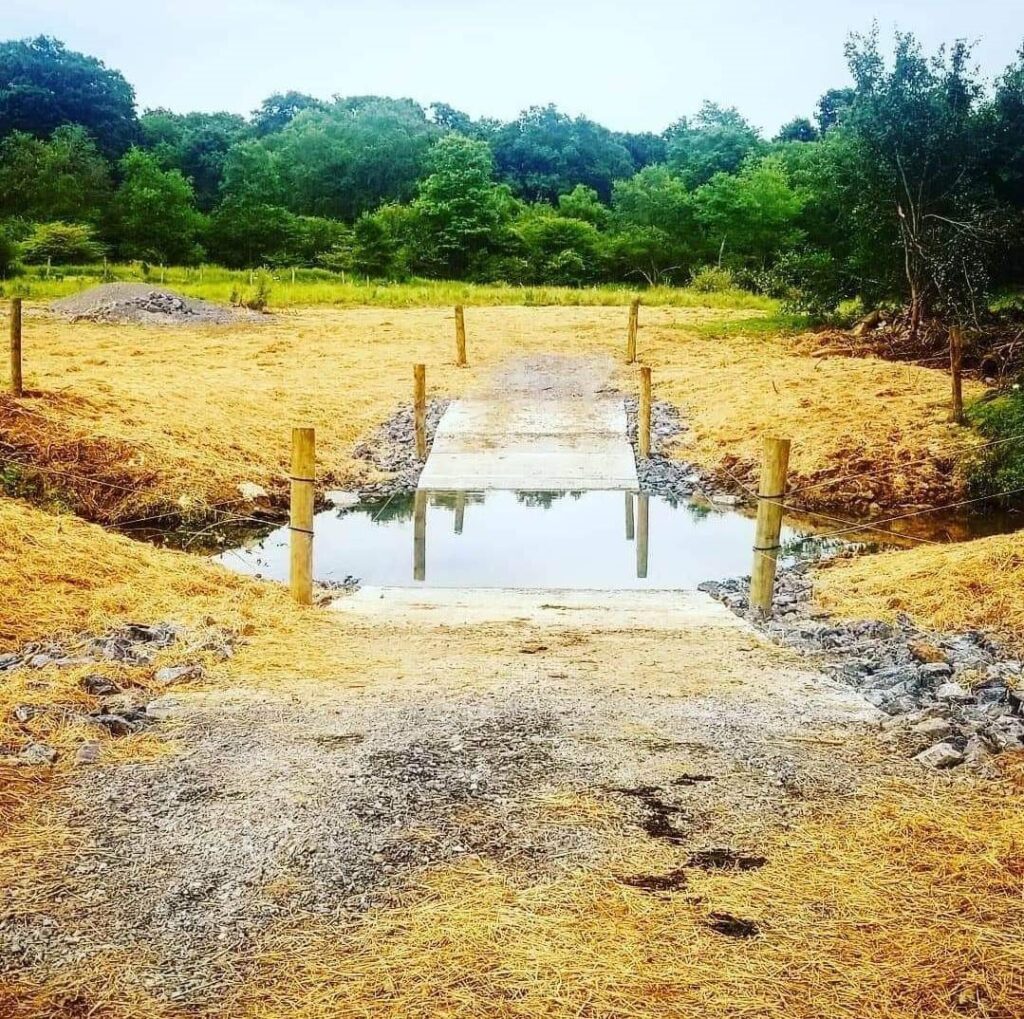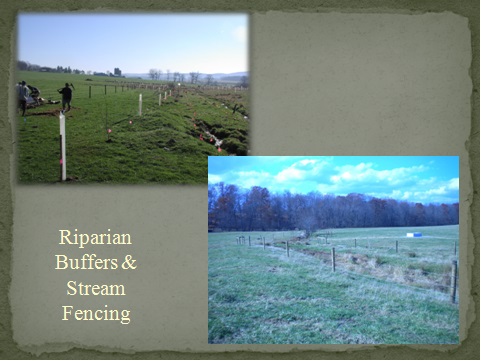EQIP FUNDING
Photo of a Garrett County farm prior to conservation efforts, 1950’s.
EQIP Funding in Garrett County
EQIP provides technical and financial assistance to agricultural producers and forest landowners to address natural resource concerns, such as:
- Improving water and air quality;
- Conserving ground and surface water;
- Increasing soil health;
- Reducing soil erosion and sedimentation;
- Improving or creating wildlife habitat; and
- Mitigation against drought and increasing weather volatility.
EQIP is a USDA NRCS program, so it is a federal program. It is administered by the NRCS. EQIP works a little differently than many of the MDA programs in that, instead of everyone who applies and qualifies being funding, there is a ranking system. Each year, the USDA allocates a certain dollar amount to Garrett County and Allegany County for EQIP projects. If all of that money is used, the GSCD can request more money from counties around Maryland that did not use all of their funds. Sometimes that creates a second round of funding for Garrett County.
Individuals or groups apply to the Garrett Soil Conservation District for funding. Once the application is complete, District employees will create a conservation plan. When the application with all of its additional documents for the particular program and the conservation plan are finalized, the application will be added to the waiting list. At this point, applications are ranked based upon the conservation benefit of the project(s). Once funding is available, the highest ranked applications in each individual program, up to the available dollar amount allocated to the county, are selected to be placed in active statis.
Once in active statis, NRCS employees will contact the applicant and begin the process to get funding approval from the USDA. At this point, applicants need to be able to work with NRCS employees to complete the final paperwork quickly, because the period to complete this step is very short. Applicants who do not complete in time will lose their place on the waiting list. This is because the USDA sets very tight deadlines, and the District does not have the ability to extend them.
Before submission for approval, applicants need to be certain that they can complete the project in 12 months once it is approved. That means that the applicant needs to be able to afford their share of the cost-share, and they need to be able to dedicate the time and resources necessary to complete the project.
Once all the paperwork is completed and verified, the application will be submitted for final approval by the USDA, and funding will be allocated.

Cattle Crossing completed by the Garrett Soil Conservation District
EQIP has funded many projects in Garrett County, but it is not a quick process. Applicants need to be aware that it may take several years to obtain grant funding for their project, and they may not be funded at all. While at the same time, they need to have their share of cost-share funding available, because some projects are slipped in at the last minute due to extra funding. And if the producer is not ready or cannot handle their share of cost-share, the application will be bumped from active status.
The FSA CREP and MDA MACS programs require individuals to have at least 8 animal units for funding. And, at 8, it is only partial funding. For full funding farmers need to have 15 animal units. An animal unit is 1,000 lbs of animal weight. EQIP does not have the animal unit requirement, so it is an attractive program for those who do not have animals or do not have that many animals on their farm.
EQIP provides funding for things like Forestry plantings and renewal, weed control, fencing, animal congregation areas, high tunnels, and many other practices. See the bottom of the page for a list.
For more information about the program, individuals should contact Chad Bucklew at chad.bucklew@usda.gov or Jacob Metcalf at jacob.metcalf@usda.gov. Either of them can be reached at 301-501-5886 as well.
This year, EQIP is expected to have a significantly higher amount of funding than it has in past years due to the Inflation Reduction Act. Therefore, farmers and landowners have a good chance at funding. So, if you have a conservation project that you would like to complete on your farm or land, you are encouraged to apply soon. Depending upon the project, there may be a wait if you need a Conservation Plan or if you need extensive design work for your project. Hence, it is recommended that you get started on the process as soon as possible.
These funds will only be available for a couple years. After that, Congress has determined that leftover funds will go to a regulatory agency to address facilitation of fines to landowners and farmers that are not in compliance with Conservation laws. They are giving farmers and landowners funding to address the issues voluntarily with this program. If farmers and landowners do not use the funds to take advantage of this opportunity, another agency, such as the EPA, may impose fines instead. This has nothing to do with our office. This was determined by the federal government. Our goal at the GSCD is to use all of the funds available to Garrett County to help farmers pay for conservation projects they want to do on their land. See the bottom of this page for a list of projects that can be completed with EQIP.
TEAMS Workgroup
The TEAMS workgroup consists of a variety of agencies in Allegany and Garrett County, including the Soil Conservation Districts, the Forestry Services, and the Extension Offices, among others.
The TEAMS Workgroup makes recommendations for developing guidelines and ranking for local funding of EQIP based on the most important conservation needs in the area. NRCS employees follow these guidelines to rank applications that have applied for EQIP funding.
TEAMS determines what funding areas should be represented and the percentage of funding that should be allocated to each of those areas. Additionally, they develop rules for ranking of applications.
Some past local projects completed with TEAMS include:
- Stream exclusion fencing
- Heavy use protection
- Roofs and Covers
- Waste Storage
- Stream Crossings
- Rotational Grazing Fencing
- Livestock Congregation Areas
- High Tunnels


Some of the Projects that Could Be Covered by EQIP
- Fencing
- High Tunnels
- Riparian Buffers
- Waste Storage Facility
- Watering Trough
- Well or Spring Development
- Roof Runoff Structure
- Heavy Use Area Protection
- Structure for Water Control
- Tree/Shrub Establishment
- Underground Outlet
- Golden-Winged Warbler Forest Plan
- Vegetated Treatment Area
- Rotational Grazing
- Wetland Creation
- Wetland Restoration
- Critical Area Planting
- Windbreak Establishment
- Composting Facility
- Grassed Waterway
- Hedgerow Planting
- Forage and Biomass Planting
- Prescribed Grazing
- Streambank Protection
- Channel Bed Stabilization
- Stream Crossing
- Barnyard Clean Water Diversion
- Filter Strip
- Subsurface Drain
- Pollinator Planting